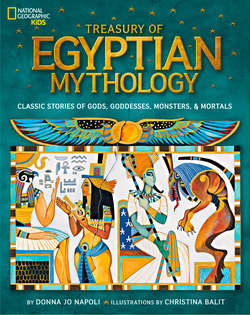Читать книгу Treasury of Egyptian Mythology: Classic Stories of Gods, Goddesses, Monsters & Mortals - Christina Balit - Страница 7
ОглавлениеINTRODUCTION
All people count on the sun. It gives them light and warmth. And they count on fresh water, too. Animals and plants need rain, even those that live in the sea, for the sea would grow too salty without it. In modern times, farmers still are concerned with sun and fresh water, because they rely on both to make plants grow, but city people might not think about it much. Our light can be turned on with a wall switch. Our water comes to us through pipes. But in ancient times, sun and fresh water were everyone’s concern.
Humans wandered through the Nile valley thousands and thousands of years ago. But around the year 7000 B.C., humans settled there for good. They lived in small, scattered tribes. They foraged and hunted for food, and they raised domesticated animals, such as cows and sheep. In those days Egypt had plenty of grassy land for animals to feed on, especially to the west of the Nile valley, and it also had a mild, wet climate.
But then the climate grew drier. The grasslands known as savannas shrank. Deserts formed. Wild animals had to move close to the Nile shores for water. People followed the animals. Soon towns appeared up and down the riverbanks. And by around 4000 B.C. people turned to farming to produce food. Perhaps there weren’t enough plants for foraging anymore. Or perhaps they learned farming from foreigners. Either way, farming meant they could feed lots of people. So towns grew large and stable.
Egyptian farmers relied on three seasons. One season was the flood, when the Nile would overflow its banks. As the floods withdrew, they left behind a muddy substance called silt. Silt is rich in minerals, and it made the soil fertile. Next came the planting and growing season. Finally came the hot and dry harvest season, the time when farmers gathered their crops.
Ancient Egyptian mythology put the sun god Ra in charge of these seasons. After all, his movement across the sky made day and his movement across the underworld made night. Because of his light, crops grew. The very pattern of Egyptian life depended upon Ra.
Egyptian mythology reflects this. Ra is one of the earliest gods, and he remains an important god throughout the long history of ancient Egypt. Most other deities begin somehow from Ra. His tongue, his eye, his saliva, his breath even—they all can step forward as independent gods and goddesses. His thoughts and words create objects and living beings. From his tears came the first humans. Perhaps the Egyptians, then, really believed in only one god—the sun god—who could take many forms.
A note to ebook readers: We hope you find the art in this book as enchanting as we do. To experience it in more detail, you may be able to enlarge it. In most reading systems, you can double tap on the image to bring up a full-screen viewer with zoom and pan functionality.
